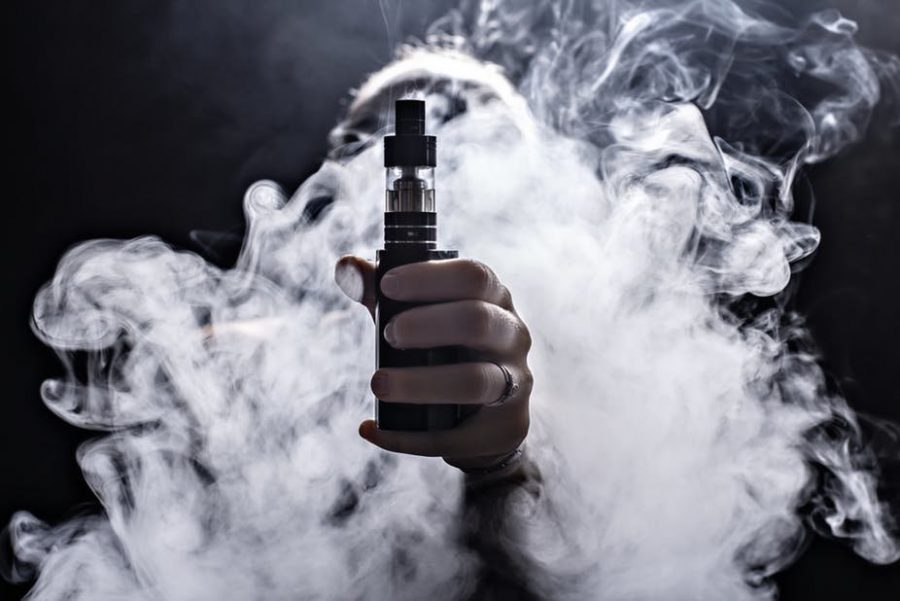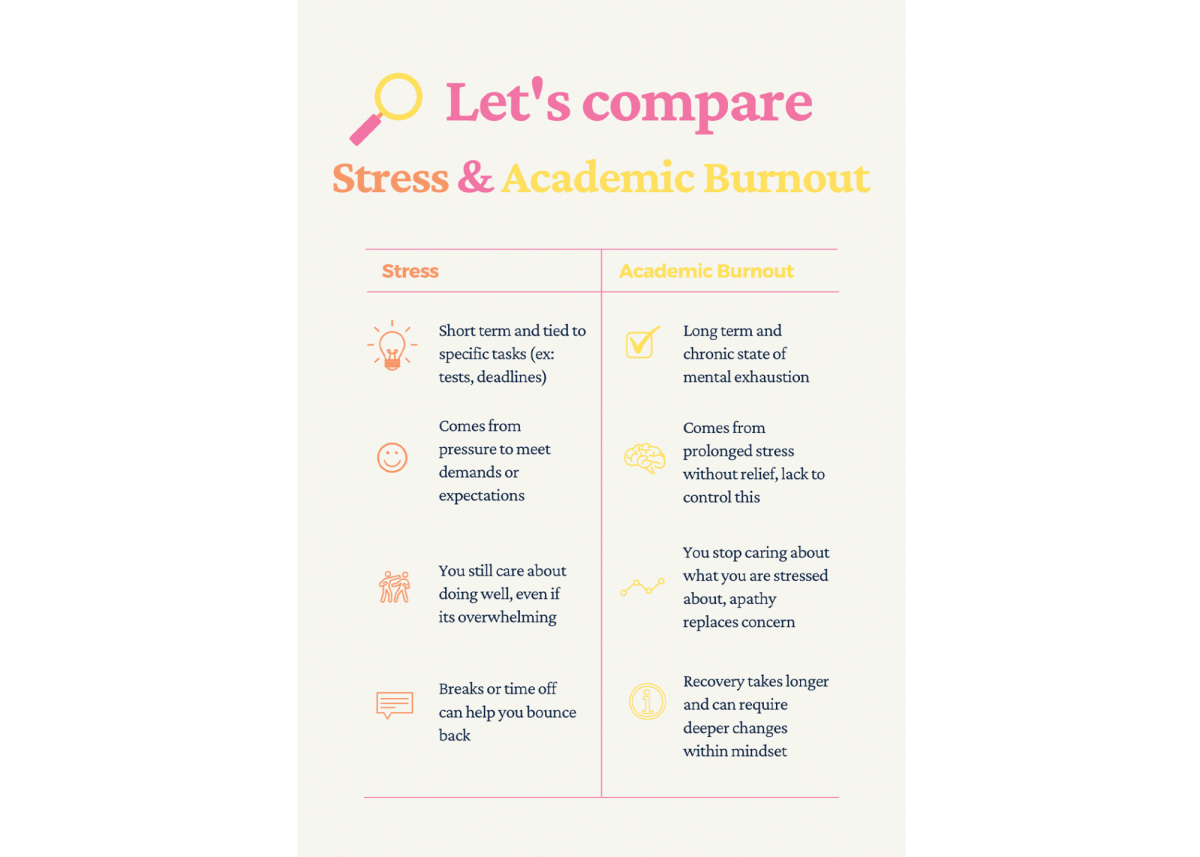The Nicotine Resurgence: What’s all the buzz?
December 2, 2018
It’s all you can think about. You feel anxious.
Just one hit.
That sweet mint sensation.
Acting sly, you stick your juul down your sleeve and inhale, hoping your juul doesn’t crackle too loud.
It didn’t. Relief. No one suspected a thing.
You exhale down the same sleeve and hope that no one around you noticed, including your teacher. The dangers of juuling in school seem voided because your withdrawals from the few hours without nicotine are the only thing at the forefront of your mind. You’re feeling tingly, and life is good. You got away with it again.
Devices once intended to help adults stop smoking are now the center of a social phenomenon amongst teens. Vaping has even been declared an epidemic by the FDA, and many of the health risks are still unknown. Yet, that hasn’t stopped students from using these devices dozens of times a day. Smoking and nicotine addiction had actually been going down in the previous years due to the health risks that come with smoking cigarettes, but now, with e-cigarettes on the rise, the rates of nicotine addiction and dependency are climbing once again.
Nicotine, though not a carcinogen (cancer causing chemical), is still the third most addictive drug on the planet, topped only by heroin and cocaine. Nicotine releases dopamine in the brain – as well as epinephrine, also produced in the brain – which in turn creates a relaxing and euphoric “buzz”, one many of America’s youth are now addicted to seeking.
One of the most notable devices, the Juul, has taken the e-cigarette market by storm due to its miniscule size. Resembling a flash drive, the Juul is easily concealable and discreet. PAX Labs, the company that created the popular device, has now since separated into its own company, Juul – grossing a $16 billion dollar worth. This is only a fraction of the $100+ billion dollar worth that traditional cigarette companies carry, but Juul is young. And growing.
Juuls hit the market in 2015 and took off in late 2017. Before that, many smokers were still reliant on chewing tobacco and cigarettes, both of which contain carcinogens. This led to over 1,000 tobacco related deaths per day in the early 2000s (CDC). However, most people know these risks, which is what makes the Juul so alluring. The Millennials grew up on anti-smoking ads and the campaigns against tobacco use, but this demographic doesn’t see juuling as dangerous.
This is a common misconception. Because cigarettes contain tar, tobacco and other forms of chemicals, many who weren’t addicted felt the need to avoid them, and those addicted felt the need to quit. But with the Juul, the health risks are not yet fully known, which leads to assumptions that there aren’t any, causing people to vape without worry.
Though vape devices don’t contain tobacco – which has been linked to cancers – there are other metals and chemicals in its place. These metals and chemicals in turn stimulate cancer cells and allow for easy reproduction of said cells.
Aside from the Juul being easily concealable, there is also no smell and no lighter, which makes it easier to use indiscreetly. Especially in schools.
For legality reasons, the names of the sources have been replaced with fake ones*, though all information and experiences are taken from students directly at Southeast.
LSE senior Sarah* has owned three Juuls and two Sourins (another form of e-cigarette), and has lost them all – but still ended up purchasing another Juul thereafter.
“[I use it] every day. I go through 4-5 pods on a weekly basis,” Sarah* said. “I mean, I don’t see a reason [to quit] to right now, if it was actually taking a toll on my health then yeah, [but] where I’m at right now I’m okay. I’ll let it kill me and then I’ll stop. I’ll be in my coffin and just be like, “one more hit”. Bury me with my juul, just like put it with my ashes. Make them into a pod flavor.”
Though Sarah* said this in jest, there are truths within the joke. Juuling started as a way to help adult smokers curb their addictions, as stated directly on their packaging. However, Juul’s marketing campaign, which led to their growth in 2017, has brought controversy as to who it was really directed at. Youth began to Juul as a social trend, and it took off in many affluent neighborhoods that were once drug free. They gained a majority of their profits through said youth and now kids as young as 12 are grappling with nicotine addictions, often unknown to their parents (CDC).
LSE Principal Brent Toalson has been working to find ways to resolve the epidemic taking place in the walls of our own school. For as long as Toalson can remember – from being a student, to a teacher, to now, the principal of LSE – there have been students using tobacco products. He said that, for a while, there wasn’t as much smoking with traditional cigarettes, but now, with the Juul, the numbers are spiking.
“It’s hard because it’s a societal problem, and as a school we get asked to fix all these other problems going on,” Toalson said. “So part of it is working with parents to educate them, so that they know what to look for. I don’t know if many parents, when the juuling first began, knew what this little device was. [It looks] like something for your computer.”
Toalson said he is trying to find ways to partner with parents, educate students and enforce consequences to stymie usage.
For students at LSE who are caught smoking an e-cigarette or in possession of one, the device is confiscated, parents are contacted and the student is given a consequence – either out-of-school suspension, or in-school suspension. “We try to take it serious, it’s a rule violation, and there are consequences you have to have to face,” Toalson said.
Aside from the Juul being easily concealable, there is also no smell and it doesn’t require a lighter, making bathrooms the ideal place to use it. As the only private commonplace at the school, the bathrooms have become a vaper’s paradise. It is not uncommon for students and staff alike to stumble upon someone vaping in the bathroom.
This brings about a new controversy – if students are having to take ‘Juul breaks’, how is this hurting their learning, aside from their health? Nicotine in the bloodstream can last anywhere from 30 minutes to two hours. If the average addicted student takes two Juul breaks a day, that’s around 10-20 minutes of missed classes per day, equating to 1-2 missed periods per week. Though the time allocated for these breaks seems minimal, Toalson thinks that maintaining the addiction can be detrimental to a student’s brain, as well as their wallets.
“Kids are having to leave class to go get their buzz, that’s not a good thing,” Toalson said. “If the juuling product [contains] any kind of nicotine product, we know that’s highly addictive. It’s not good for the brain to be inundated with these various types of chemicals. I worry that this may lead to lifelong addiction problems [and] spending a lot of money on those products. It gets really expensive.”
Sarah*, an LSE senior, has seen first-hand how her addiction has impacted her learning.
“[If I’m going through withdrawals] I get very distracted and it’s all I think about. I just need something to do, and something to do with my hands, and [when I hit it] I just feel refreshed and refocused.”
Juuling, in essence, becomes like a circadian rhythm for the addicted user. Most start and end their day with a buzz.
So how, exactly, did Juul take off? According to the U.S. Department of Health and Human Services, the use of cigarettes was at an all-time low in 2015, with just 5.5 percent of high school seniors reporting that they smoked daily. Compare this to forty years ago, when nearly 29 percent of high school seniors reported smoking cigarettes daily. It seemed like those anti-tobacco advertisements had worked and the nation’s addiction to smoking was burning out.
However, the Centers for Disease Control and Prevention reported the decline of cigarette use revealed an increase in vaping.
A 2016 report from the US Surgeon General raised another alarm on the growing epidemic, citing a 900% increase in e-cigarette use by high school students from 2011 to 2015, and the 2016 National Youth Tobacco Survey noted that 1.7 million high school students said they had used e-cigarettes in the previous 30 days.
The Juul has even made a name for itself in our vocabulary and turned itself into a verb – it’s not smoking or vaping, it’s “juuling”.
But the real popularization of the Juul and other e-cigarettes can be credited to social media influencers who have taken the world by storm and helped turn vaping into a social trend.
Though the Juul account (@juulvapor) only has a following of 72k, their associated hashtags contain over 7.5 million posts. These posts have fostered a meme-indoctrinated culture that students want to take part in, per the usual norm of trends.
Jia Tolentino, a journalist for the New Yorker, compared juuling to scrolling through social media feed, writing that “[Juuls] offer similar forms of contemporary pleasure. Both provide stimulus when you’re tired and fidgety, and both tend to become mindless tics that fit neatly into rapidly diminishing amounts of free time.”
Not only has juuling become a way to pass time, it is also used to fit in at social gatherings, like a concert or party. “You’re expected to Juul, but you’re expected to not depend on it,” Sarah* said. “If you’re cool, then you Juul with other people, and you post about it, so everyone will see that you’re social and ironic and funny. But, if you’re addicted, you go off by yourself and Juul because you need it, and everyone knows.”
Juuling has become so ingrained in youth culture that some find it strange to see an adult with a device.
“I’m always surprised when I see an adult with a Juul,” Sarah* said. “It’s sort of like seeing my grandma with an Alexa.”
Even though e-cigarette usage is at an all-time high, some students are realizing the true effects of this trend. Nathan*, an LSE senior who quit juuling, found that being part of the trend wasn’t worth it.
“I didn’t think of it as something cool, I knew it was stupid and basic to do. I made fun of myself every time I had it,” Nathan* said. “I don’t know why I ended up deciding to get it – it was an impulse buy I guess. For a week in summer I was [vaping nicotine] all day, and when I stopped, I was a little – like feeling weird, I was definitely doing it too often. I didn’t want to be a nicotine addict.”
In addition to the Juul being used to smoke nicotine pods, vaping devices can also be used to smoke marijuana. Because of this, many comparisons are being drawn between marijuana and nicotine. However, THC, the compound in marijuana that gets the user high, is non-addictive, whereas the chemical makeup of nicotine is addictive. People see vaping as a social phenomenon, when really, it’s not – it’s addictive. Students go from “Can I get a hit,” to breathing in more Juul vapor than air -the likeness of which is not capable with marijuana.
“It’s like Tide pods,” Nathan* said. “Kids are doing it for the irony and the clout.”
Finally, how are all these kids getting their Juuls? The elusive – and illegal – process of getting ahold of these devices has made the trend that much more appealing. John* an 18-year-old LSE senior, saw a demand and knew he could be the supplier and turn a major profit. This business venture was inspired, in part, by an LSE alumni who, John* said, made a lot of money selling to underage students.
Though John* doesn’t vape anymore, almost all of his friends do. When they need a “plug” (supplier), he’s got them. He started by advertising on his snapchat when he turned 18 and now, he just lets the word carry, much like Juul’s own marketing tactic.
As Tolentino wrote in her article, “The black-and-white photograph of James Dean smoking in shirtsleeves has been replaced with paparazzi snaps of Ben Affleck ripping an e-cig in his car.”
Tolentino’s sentiments about the culture surrounding vaping have already found footing, even amongst the LSE student body and teens across the country.
“Everyone’s doing it,” John* said. “[It’s] just like smoking back in the day.”








